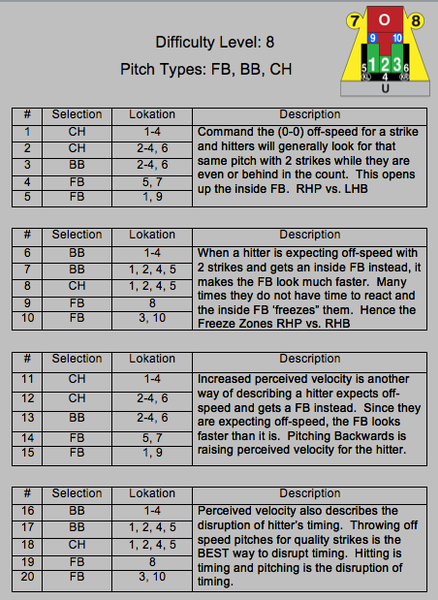
Great articles and references on Pitching Strategy and Sequencing of pitches. Mastering this part of the game will make your pitching staff better immediately.
from SABR.org:
Statcast puts analyses like the ones the Astros are reported to have done within the grasp of fans and analysts like us.
The Astros' analysts noticed that McHugh had a world-class curveball. Most curves spin at about 1,500 times per minute; McHugh's spins 2,000 times. The more spin, the more the ball moves during the pitch—and the more likely batters are to miss it. Houston snapped him up. "We identified him as someone whose surface statistics might not indicate his true value," says David Stearns, the team's 29-year-old assistant general manager." –Extreme Moneyball
The Astros tweaked McHugh's approach, tasking him with throwing fewer sinkers and more high fastballs. They encouraged him to use his high-spinning curveball, and taught him one weird trick to get MLB hitters out that professional hitting coaches hated them for sharing. They used data, insight, and coaching to turn a scrap-heap player into a highly productive major-league starter.
34.8
The percentage of pitches the Astros have thrown low and away, in the two zones to lefties and the two zones to righties outlined in the double-barreled strike-zone diagram below (from the catcher's perspective):

That rate is 1.8 deviations above the average percentage of pitches thrown in those zones. In other words, the Astros have lived low and away. Houston's Opening Day starter, Dallas Keuchel, is the king of the low-outside corner: 40.8 percent of his pitches have passed through one of those sections, and no pitcher this season has thrown more pitches to righties in Zones 9 and 14. It's obvious that avoiding the middle of the plate is a smart approach for pitchers, but the full significance of the Astros' low-and-away fixation takes a few more stats to explain.
89.6
The Astros' average fastball velocity, in miles per hour — the slowest of any team.2
There's usually a penalty associated with a lack of velocity, but the Astros have found a way to minimize it. One way they compensate for throwing the slowest fastballs is by also throwing the fewest four-seamers, topping or coming close to the top of the leaderboards for sinker, slider, and cutter rate instead. But the Astros have another secret to surviving low velo.
In a sense, the Astros are adhering to a pitching cliché: "hard in, soft away." They don't have hard, so they go away often. But something else sets them apart: Even when the Astros do throw the closest thing they have to heat, they still aim low and away, placing 30.5 percent of their fastballs in the four zones discussed above — the most in the majors, and 2.2 standard deviations above the league-average rate. They're pitching away, period.
Counterintuitively, this might actually make sense. Last year at The Hardball Times, Noah Woodward went looking for the hallmarks of aperfect fastball. What he found is that the perfect fastball has a different definition depending on where it's thrown. On the inside part of the plate, hard fastballs are far superior to soft ones, as one would suspect. But down and away is the one area where soft fastballs are better. The Astros are painting the part of the zone where slow fastballs flourish.

Woodward noted that on the outside edge, slow fastballs are called strikes more often than fast ones, which might help explain why Astros catcher Jason Castro rates as the seventh-most-valuable framer this season.3The fact that they've found the perfect place to sneak slow fastballs by batters might be why the Astros' results on four-seamers rate just above average, even though Houston is last in velocity and at or near the bottom in both vertical and horizontal movement.
Maybe the Astros are actually targeting soft-tossers because they believe they're undervalued — flamethrowers are expensive, and they're more likely to break — or maybe they're making the best of a bad hand. Either way, it's working, although it's an approach without much margin for error.
Sent from my iPhone

No comments:
Post a Comment